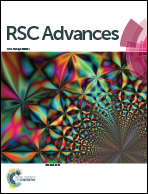Wide bandgap materials design toward tunable bandgap and increased carries injection property: silane interrupting π-conjugation together with peripheralcarbazolyl substituents†
Abstract
A series of wide bandgap materials constructed by silicon-interrupted backbone and non-conjugated carbazole pendants, namely SiPPF, SiPPFCz, SiPF and SiPFCz, are designed and synthesized. Their applications as hosts for triplet emitters in phosphorescent polymer light-emitting diodes (PhPLEDs) are systematically studied. The results show that their photophysical and carries injection properties could be finely tuned by regulating the silicon-confined conjugation length and the peripheral carbazole substituents, respectively. Among them, SiPFCz achieves a compromise of essential demands for ideal electrophosphorescent host materials, such as high triplet energy levels, small barriers for carries injection and homogeneous morphology as well as good miscibility to the dopants. Therefore, the performances of SiPFCz-based devices are superior to devices hosted by SiPPF, SiPPFCz and SiPF, which sheds light on the design strategy of wide bandgap host materials.


 Please wait while we load your content...
Please wait while we load your content...